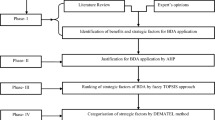Abstract
Manufacturing “smart connected products” and building “factories of future” are need of the hour in global manufacturing arena, which is forcing enterprise decision makers to develop deeper insight in relevance of emerging technologies in enterprise resource planning (ERP) such as mobility, cloud computing, analytics, social network computing and Internet of Things (IoT) to leverage them for strategic benefit and competitive advantage. In this paper, we explore strategic engagement of these technologies in manufacturing enterprises. We conducted exploratory factor analysis (EFA) of the benefits and studied their impact on four objective indicator areas such as employee, process, customer, and finance. We used IBM SPSS to perform EFA on the response data from questionnaire survey to identify critical benefit factors and beneficiary objective indicators. We compared our work with other research findings. This work will help practitioners develop better insight and decisiveness for investing in advanced technologies in pursuit of manufacturing excellence. For academia, the work will open new research directions.
Similar content being viewed by others
References
Atluru S, Huang SH, Snyder JP (2012) A smart machine supervisory system framework. Int J Adv Manuf Technol 58(5):563–572. doi:10.1007/s00170-011-3405-4
Basu R, Biswas D (2013) An approach to identify failure factors of enterprise application implementation in Indian micro enterprises. Int J Managing Value Supply Chains (IJMVSC) 4(1):37–47. doi:10.5121/ijmvsc.2013.4104
Chofreh AG, Goni FA, Shaharoun AM, Ismail S, Kleme JJ (2014) Sustainable enterprise resource planning: imperatives and research directions. J Clean Prod 71:1–9. doi:10.1016/j.jclepro.2014.01.010
Engebrethson R (2012) Comparative analysis of ERP emerging technologies. MS Thesis California Polytechnic State University, San Luis Obispo http://digitalcommons.calpoly.edu/cgi/viewcontent.cgi?article=1779&context=theses
Gupta A (2000) Enterprise resource planning: the emerging organizational value systems. Ind Manag Data Syst 100(3):114–118. doi:10.1108/02635570010286131
Habidin NF, Yusof SM, Omar B, Mohamad SIS, Janudin SE (2012) A proposed strategic balanced scorecard model: strategic control system and organizational performance in Malaysian automotive industry. IOSR J Bus Manag (IOSRJBM) 1(6):39–44, ISSN: 2278-487X
Hair JF, Black WC, Babin BJ, Anderson RE (2009) Multivariate data analysis. 7th ed. Prentice Hall ISBN-13: 978–0138132637
Henderson JC, Venkatraman N (1993) Strategic alignment: leveraging information technology for transforming organizations. IBM Syst J 32(1):4–16. doi:10.1147/sj.382.0472
Hurbean L, Fotache D (2013) Mobile technology: binding social and cloud into a new enterprise application platform. Inf Econ 17(2):73–83. doi:10.12948/issn14531305/17.2.2013.06
Johansson B, Sudzina F (2008) ERP systems and open source: an initial review and some implications for SMEs. J Enterp Inf Manag 21(6):649–658. doi:10.1108/17410390810911230
Kaplan RS (2008) Conceptual foundations of the balanced scorecard. Handb Manag Account Res 3:1253–1269. doi:10.1016/S1751-3243(07)03003-9
Kaplan RS, Norton DP (1992) The balanced scorecard—measures that drive performance. Harv Bus Rev. doi:10.1225/92105
Kaplan RS, Norton DP (1996) Linking the balanced scorecard to strategy. Calif Manag Rev 39(1):53–79. doi:10.2307/41165876
Khajeh-Hosseini A, Greenwood D, Sommerville I (2010) Cloud migration: a case study of migrating an enterprise IT system to IaaS. In IEEE 3rd Int Conf on Cloud Comput (CLOUD “10) pp 450–457 doi:10.1109/CLOUD.2010.37
Kim JO, Mueller CW (1978) Factor analysis: statistical methods and practical issues. SAGE Publications ISBN-13: 978–0803911666
Lee HG, Na HB, Shin K, Jeong H, Park J (2007) Performance improvement study for MRP part explosion in ERP environment. Int J Adv Manuf Technol 35(3):309–324. doi:10.1007/s00170-006-0718-9
Matthews D (2014) Five trends that will shape the future of ERP. Industry-Week White paper http://www.industryweek.com/technology/five-trends-will-shape-future-erp
O’Leary DE (2004) Enterprise resource planning (ERP) systems: an empirical analysis of benefits. J Emerg Technol Account 1(1):63–72. doi:10.2308/jeta.2004.1.1.63
Ou-Yang C, Chang MJ (2006) Developing an agent-based PDM/ERP collaboration system. Int J Adv Manuf Technol 30(3):369–384. doi:10.1007/s00170-005-0076-z
Porter ME, Heppelmann JE (2014) How smart, connected products are transforming competition. Harvard Business Review, November Issue
Ram J, Corkindale D, Wu ML (2014) ERP adoption and the value creation: examining the contributions of antecedents. J Eng Technol Manag 33:113–133. doi:10.1016/j.jengtecman.2014.04.001
Themistocleous M, Irani Z, Love PED (2002) Enterprise application integration: an emerging technology for integrating ERP and supply chains. In European Conf of Infor on Systems (ECIS 2002):1087–1096 http://aisel.aisnet.org/cgi/viewcontent.cgi?article=1089&context=ecis2002
Ularu EG, Puican FC, Suciu G, Vulpe A, Todoran G (2013) Mobile computing and cloud maturity—introducing machine learning for ERP configuration automation. Inf Econ 17(1):40–52. doi:10.12948/issn14531305/17.1.2013.04
Wei CC (2008) Evaluating the performance of an ERP system based on the knowledge of ERP implementation objectives. Int J Adv Manuf Technol 39(1):168–181. doi:10.1007/s00170-007-1189-3
Wei Z, Tan J, Feng Y (2009) Integration technology of ERP and PDM based on business remote function call. Int J Adv Manuf Technol 40(9):1044–1052. doi:10.1007/s00170-008-1419-3
Zeng Y, Chiang RHL, Yen DC (2003) Enterprise integration with advanced information technologies: ERP and data warehousing. Inf Manag Comput Secur 11(3):115–122. doi:10.1108/09685220310480390
Author information
Authors and Affiliations
Corresponding author
Rights and permissions
About this article
Cite this article
Ranjan, S., Jha, V.K. & Pal, P. Application of emerging technologies in ERP implementation in Indian manufacturing enterprises: an exploratory analysis of strategic benefits. Int J Adv Manuf Technol 88, 369–380 (2017). https://doi.org/10.1007/s00170-016-8770-6
Received:
Accepted:
Published:
Issue Date:
DOI: https://doi.org/10.1007/s00170-016-8770-6




